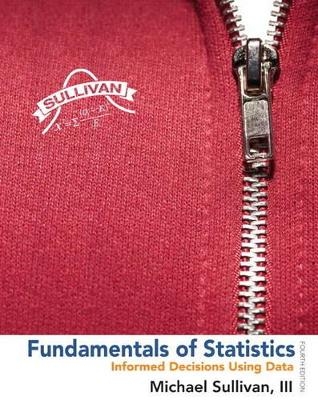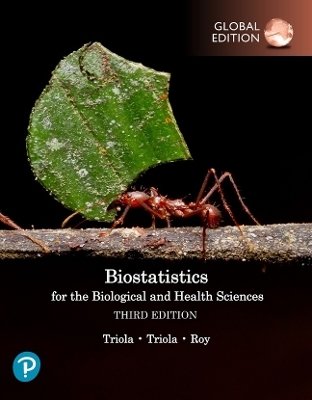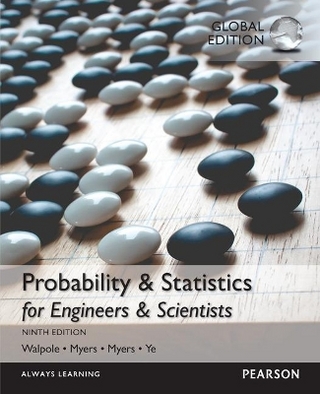
Fundamentals of Statistics Plus NEW MyStatLab with Pearson eText -- Access Card Package
Pearson
978-0-321-87622-5 (ISBN)
- Titel ist leider vergriffen;
keine Neuauflage - Artikel merken
Packages
Access codes for Pearson's MyLab & Mastering products may not be included when purchasing or renting from companies other than Pearson; check with the seller before completing your purchase.
Used or rental books
If you rent or purchase a used book with an access code, the access code may have been redeemed previously and you may have to purchase a new access code.
Access codes
Access codes that are purchased from sellers other than Pearson carry a higher risk of being either the wrong ISBN or a previously redeemed code. Check with the seller prior to purchase.
--
Drawing upon his passion for statistics and teaching, Mike Sullivan addresses the needs of today’s students, the challenges teachers face, and changes in the statistics community. With feedback from his own students and classroom experience, Fundamentals of Statistics provides the tools to help students learn better and think statistically in a concise, friendly presentation.
0321876229 / 9780321876225 Fundamentals of Statistics Plus MyStatLab -- Access Card Package
Package consists of
032183870X / 9780321838704 Fundamentals of Statistics
0321847997 / 9780321847997 My StatLab Glue-in Access Card
032184839X / 9780321848390 MyStatLab Inside Sticker for Glue-In Packages
With training in mathematics, statistics, and economics, Mike Sullivan, III has a varied teaching background that includes 15 years of instruction in both high school and college-level mathematics. He is currently a full-time professor of mathematics and statistics at Joliet Junior College. Mike has numerous textbooks in publication in addition to his Introductory Statistics Series, which include a Developmental Math series, and a Precalculus series, which he writes with his father, Michael Sullivan. Mike has built this book in the classroom using feedback from his students. He is well aware of the challenges of students taking an introductory statistics course. His goal is for students to be more informed interpreters of data, so that they will be better decision makers and have stronger critical-thinking skills. When not in the classroom or writing, Mike enjoys spending time with his three children, Michael, Kevin, and Marissa, and playing golf. Follow Mike on Facebook® (www.facebook.com/SullyStats) and Twitter (@SullyStats).
Part 1: Getting the Information You Need
1. Data Collection
1.1 Introduction to the Practice of Statistics
1.2 Observational Studies versus Designed Experiments
1.3 Simple Random Sampling
1.4 Other Effective Sampling Methods
1.5 Bias in Sampling
1.6 The Design of Experiments
Chapter 1 Review
Chapter Test
Making an Informed Decision: What College Should I Attend?
Case Study: Chrysalises for Cash
Part 2: Descriptive Statistics
2. Organizing and Summarizing Data
2.1 Organizing Qualitative Data
2.2 Organizing Quantitative Data: The Popular Displays
2.3 Graphical Misrepresentations of Data
Chapter 2 Review
Chapter Test
Making an Informed Decision: Tables or Graphs?
Case Study: The Day the Sky Roared
3. Numerically Summarizing Data
3.1 Measures of Central Tendency
3.2 Measures of Dispersion
3.3 Measures of Central Tendency and Dispersion from Grouped Data
3.4 Measures of Position and Outliers
3.5 The Five-Number Summary and Boxplots
Chapter 3 Review
Chapter Test
Making an Informed Decision: What Car Should I Buy?
Case Study: Who Was A Mourner?
4. Describing the Relation between Two Variables
4.1 Scatter Diagrams and Correlation
4.2 Least-Squares Regression
4.3 The Coefficient of Determination
4.4 Contingency Tables and Association
Chapter 4 Review
Chapter Test
Making an Informed Decision: Relationships among Variables on a World Scale
Case Study: Thomas Malthus, Population, and Subsistence
Part 3: Probability and Probability Distributions
5. Probability
5.1 Probability Rules
5.2 The Addition Rule and Complements
5.3 Independence and the Multiplication Rule
5.4 Conditional Probability and the General Multiplication Rule
5.5 Counting Techniques
5.6 Putting It Together: Which Method Do I Use?
Chapter 5 Review
Chapter Test
Making an Informed Decision: The Effects of Drinking and Driving
Case Study: The Case of the Body in the Bag
6. Discrete Probability Distributions
6.1 Discrete Random Variables
6.2 The Binomial Probability Distribution
Chapter 6 Review
Chapter Test
Making an Informed Decision: Should We Convict?
Case Study: The Voyage of the St. Andrew
7. The Normal Probability Distribution
7.1 Properties of the Normal Distribution
7.2 Applications of the Normal Distribution
7.3 Assessing Normality
7.4 The Normal Approximation to the Binomial Probability Distribution
Chapter 7 Review
Chapter Test
Making an Informed Decision: Stock Picking
Case Study: A Tale of Blood Chemistry and Health
Part 4: Inference: From Samples to Population
8. Sampling Distributions
8.1 Distribution of the Sample Mean
8.2 Distribution of the Sample Proportion
Chapter 8 Review
Chapter Test
Making an Informed Decision: How Much Time Do You Spend in a Day...?
Case Study: Sampling Distribution of the Median
9. Estimating the Value of a Parameter
9.1 Estimating a Population Proportion
9.2 Estimating a Population Mean
9.3 Putting It Together: Which Procedure Do I Use?
Chapter 9 Review
Chapter Test
Making an Informed Decision: How Much Should I Spend for This House?
Case Study: Fire-Safe Cigarettes
10. Hypothesis Tests Regarding a Parameter
10.1 The Language of Hypothesis Testing
10.2 Hypothesis Tests for a Population Proportion
10.3 Hypothesis Tests for a Population Mean
10.4 Putting It Together: Which Method Do I Use?
Chapter 10 Review
Chapter Test
Making an Informed Decision: Selecting a Mutual Fund
Case Study: How Old Is Stonehenge?
11. Inferences on Two Samples
11.1 Inference about Two Population Proportions
11.2 Inference about Two Means: Dependent Samples
11.3 Inference about Two Means: Independent Samples
11.4 Putting It Together: Which Method Do I Use?
Chapter 11 Review
Chapter Test
Making an Informed Decision: Which Car Should I Buy?
Case Study: Control in the Design of an Experiment
12. Inference on Categorical Data
12.1 Goodness-of-Fit Test
12.2 Tests for Independence and the Homogeneity of Proportions
12.3 Testing the Significance of the Least-Squares Regression Model
12.4 Confidence and Prediction Intervals
Chapter 12 Review
Chapter Test
Making an Informed Decision: Benefits of College
Case Study: Feeling Lucky? Well, Are You?
Additional Topics on CD
C.1 Lines
C.2 Estimating a Population Standard Deviation
C.3 Hypothesis Tests for a Population Standard Deviation
C.4 Comparing Three or More Means (One-Way Analysis of Variance)
Appendix A. Tables
Photo Credits
Answers
Index
| Sprache | englisch |
|---|---|
| Maße | 216 x 274 mm |
| Gewicht | 1361 g |
| Themenwelt | Mathematik / Informatik ► Mathematik ► Statistik |
| ISBN-10 | 0-321-87622-9 / 0321876229 |
| ISBN-13 | 978-0-321-87622-5 / 9780321876225 |
| Zustand | Neuware |
| Haben Sie eine Frage zum Produkt? |
aus dem Bereich

